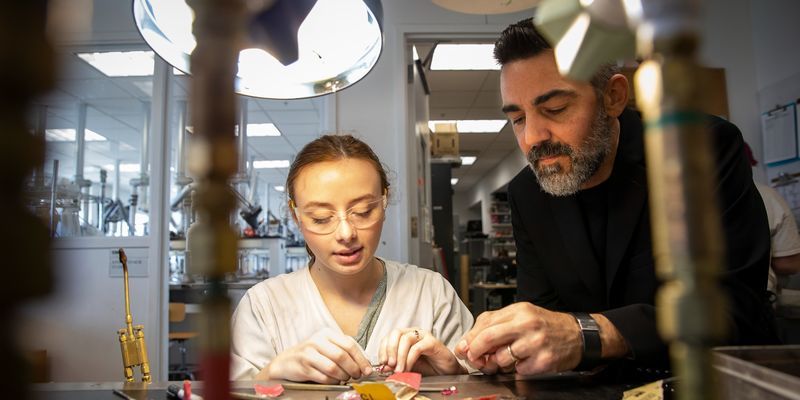College of Engineering team working towards a pickleball noise solution
Mechanical engineering faculty Haijun Liu and PhD candidate Subhrodeep Ray are on the cusp of a solution that can satisfy both pickleball players and nearby residents in disputes across the nation in the form of an absorptive sound barrier.

A few years ago, a pickleball court in Chestnut Hill made headlines when people living nearby began complaining about the incessant noisiness of the ball hitting the racket. It was then that Temple University’s College of Engineering began researching sound at the facility.
Now, Associate Professor of Mechanical Engineering Haijun Liu and international PhD candidate Subhrodeep Ray are on the cusp of a solution. They believe their findings may satisfy both players and residents in similar disputes across the nation in the form of an absorptive sound barrier.
The high-pitched popping sound of a pickleball being hit is much harsher than the dull thud emitted by a tennis ball. As more tennis courts across the country are being utilized for pickleball, noise complaints have become more prevalent, which is what we saw in 2022 within the Chestnut Hill neighborhood of Philadelphia.
Liu was approached with the problem by a fellow Temple colleague, who was also a pickleball player and resident of Chestnut Hill.
Liu and Ray began measuring the decibel and frequency levels of the sound from the court while also conducting interviews with pickleball court neighbors across the country.
“Based on a lot of interviews with residents, not only in Philadelphia but people in Arizona and California, it’s a big issue ... the continuous popping sound. Some people compared it to a form of torture,” said Ray.
While current noise reduction products exist, Liu and Ray found they aren’t optimized for the unique problem of pickleball noise.
Broadband absorption materials are too bulky, so they are unable to be hung on existing fencing. Reflective sound barriers create an echo effect, making a noisier court for players, and ultimately creating more sound that will eventually spill out from the top of the uncovered courts.
Based on their findings, the two worked to develop a unique solution that seeks to solve the problem for both parties: a new type of barrier that effectively absorbs noise without compromising aesthetics or safety.
Their sound barrier, made of acrylic plastic, consists of a perforated front panel and a solid back panel with an air gap between the two.
The perforation size and spacing, in addition to the spacing between the two panels, has been optimized to reduce the sound of the specific frequency emitted by a pickleball hitting the racket.
After noise reduction, safety, aesthetics and cost were other significant concerns for both players and residents.
“Nobody wants to open their window or come out in their backyard and see a huge black curtain,” explained Ray. In addition to its less than desirable appearance, nontransparent sound barriers pose another issue.
"In a rec center, they don’t want to have material that’s not transparent,” Liu adds. "You can’t see what’s going on in the court. It’s a safety concern."
The unique combination of cost, safety and aesthetics made acrylic plastic the ideal material for their product.
Using acrylic material is affordable and allows for a transparent sound barrier. Acrylic can also handle the extreme fluctuations of Philadelphia weather, performing well under intense heat, below-freezing temperatures and record-level wind velocity.
Additionally, their unique design allows rec centers to swap out any cracked or shattered panels individually, providing a more cost-effective option as opposed to ordering an entirely new larger panel.
The team is completing additional testing in their lab to optimize the product, and they hope to install the panels for a pilot study at the Water Tower Recreation Center courts later this year.
In the lab, the product is demonstrating a rate of 90% sound absorption when the sound wave hits the panels perpendicularly.
The next step is to ensure that the sound barrier can provide a minimum rate of 50% sound absorption when the sound wave hits the panel at various angles up to 45 degrees. Once they’ve collected that data, they hope to move forward with the installation at the courts for a pilot study.
“At the end, the neighbors have to agree that this is a good solution,” said Ray. “Getting their feedback once it’s all installed will give us the opportunity to fine tune it for the future.”
Liu and Ray interviewed pickleball court neighbors from across the country who organized themselves in a pickleball noise relief Facebook group. Members of the group expressed that any strategy for pickleball sound mitigation needs to be a multifaceted approach that includes a national standard for pickleball noise measurement, study on the psychological effects of continuous exposure to pickleball noise, and, more importantly, investment into building new indoor facilities or outdoor courts without impacting residents.
As pickleball approaches 14 million players in the United States alone, more than double from the time the Chestnut Hill dispute began in 2022 according to the USA Pickleball Association, Liu and Ray’s sound barrier aims to compromise between avid players and concerned residents across the nation.


